167. $500
“E. & G.W. Bartholomew, Bristol, Conn.”, hollow column shelf clock, ca 1828-1832. George was in business with his cousin Eli in 1832-1833.Their most unique product was the hollow column clock. A number of other clockmakers also manufactured them but the Bartholomew’s are credited with originating them. The mahogany case with carved and gilded eagle splat, two freestanding ebonized and gilded columns, wooden dial with Roman numerals, and painted glass flanked by free-standing gilded columns, the lower door with reverse painted tablet with two stately homes within a gilded border. There is a near perfect maker’s label inside on the backboard with maker’s name as above, thirty-hour time and strike wooden movement with pressed brass pendulum bob and two cast iron weights with old gold paint. The case stands 36 inches high. An identical clock belonging to Dr. Martin Baker sold at auction in 2011 for several thousand dollars. It had paw feet, no finials, ours has finials, no feet. Wood dial has old holes filled and new holes drilled. The top door is hinged on the left, latches on the right. Bottom door is hinged on the right and has ivory escutcheon and lock and key. There are many references for this maker, one is: “Eli Terry & The Connecticut Shelf Clock”, Second Edition Revised, by Kenneth D. Roberts and Snowden Taylor, page 223-224. We found several examples that sold at auctions in recent years, some with brass finials, some with wood finials, some with carved feet, and some without. $750-$1000.
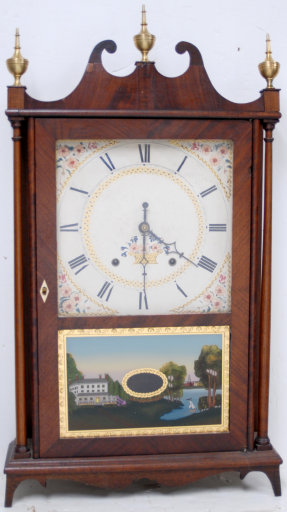
168. $250
“Eli & Samuel Terry / Made and Sold at Plymouth, Connecticut”,
pillar and scroll clock, ca 1824-1827. They were partners for three years making pillar & scroll clocks. The labels for most pillar
and scroll clocks sold during this period said the clocks were invented by Eli Terry and sold by Samuel Terry, Seth Thomas, or whomever.
This clock is typical of most all P&S cases. The glasses are old but are good replacements. Excellent paper
label, the dial is wonderful, there are old hands, pendulum, iron bell, iron weights, and door lock with escutcheon and key. The tips
of the scrolls have been repaired, chimneys, and returns, are all original. The bottom looks to be all original but there is a piece
of the right rear foot missing. With a little effort this could be a much better clock. Have the foot repaired and make the scroll
tips look better. $300-$500.
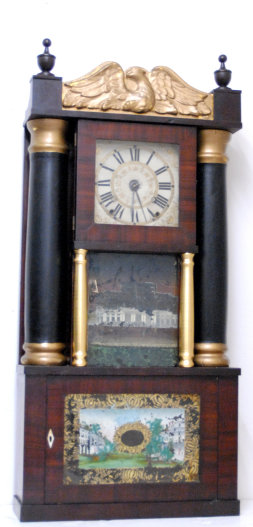


169. $300
“Lawyer Byington, Newark Valley Tioga County, N.Y.”, carved column and splat, mantel clock, ca 1826-1845. He made cases and used Terry and Groaner type wood movements from Connecticut. Our clock is a groaner 30-hour wood movement with iron bell on top of the case. The wood dial and label are excellent, pendulum, hands, iron weights are typical and period for this style clock. The 37-inch-high rosewood veneered case has been restored, thoroughly cleaned and polished, has replaced glasses but otherwise appears to be original. Certainly a very nice example of an early wood movement carved clock. $300-$500.
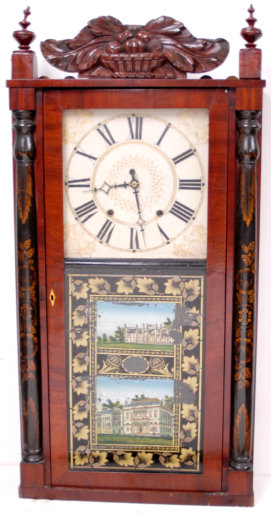
170. $300
“JEROMEs’ & DARROW, / Bristol, Conn.”, eight-day wood movement in a rosewood veneered case with stenciled half columns and a carved top, ca 1828-1833, probably 1832. The large case is 37 inches tall, retaining all the original finish that has darkened over time as you would expect. From the exceptional carved top to the base it is all original including the splat. Damaged or missing veneer has been repaired, only one small chip on the door and it is probably original veneer, just glued back. All the glasses are probably original. There has been some patching of lost putty but I do not believe the glasses have been out of the door. There is a door lock and escutcheon but no key. I had to rent a forklift to move the huge pair of old iron weights. The brass bob, excellent wood dial and period hands are period and probably original. Inside are the complete label and the 8-day wood movement. The movement is clean, it is complete, it has ivory bushings per the label, and is in operating condition. The large iron weights are compounded using two sets of pulleys. This carved case wood movement clock is very nice. The case, movement, label, etc. are pictured and described in “The Story of Chauncey Jerome”, by Chris Bailey, pages 19-42. $300-$500.
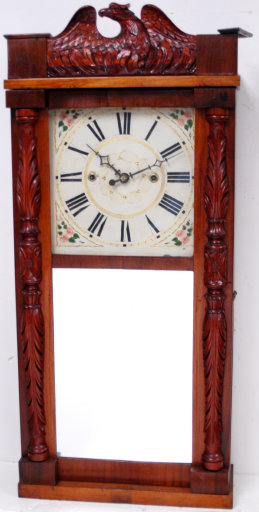
171. $250
JEROMEs’ & DARROW, Bristol, Conn.”, carved splat and stenciled column 8-day wood movement clock, ca 1828-1833. The label further says, “Improved Clocks, Made And Sold By Jeromes & Darrow”. Partners were Chauncey and Noble Jerome, and Elijah Darrow. This type clock displaced the popular pillar & scroll clocks and it encouraged other makers to experiment with new case styles, including the use of stenciled columns and splats, carved columns and splats, looking glasses (mirrors) and other innovations. This clock has the Noble Jerome 8-day movement, and they also experimented with groaners and Terry type wood movements. The stenciling is dark but very good. The carved splat is also very nice but dark and probably never cleaned. Some gluing has been done on the capitals and returns. The mahogany ? veneered case is very dark, stands 36 inches tall and probably has replaced glasses although the bottom glass has a lot of paint missing from the back. The wood dial is excellent, has a proper pair of large iron weights, old pendulum bob, iron bell, hands, ivory escutcheon, key lock, but no key. $300-$500.
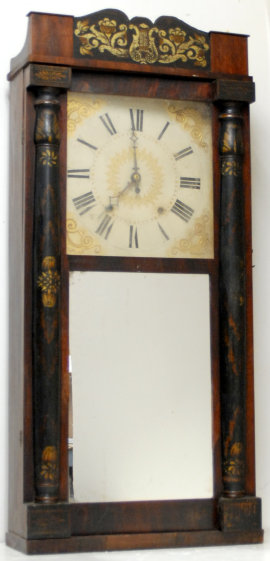
172. $150
“Riley Whiting / Winchester, Connecticut.”. column and splat shelf clock with wood movement, ca 1828-1835. The label is large and complete, covering 2/3rds. of the backboard. The mahogany veneered case is very nice, has some veneer chips on the bottom board, stenciled half columns and splat that have good strong stenciling. The chimneys, caps and returns are all good. Door latch on the right side, hinges on the left. The case is 35” tall, mirror is old, may be original, top glass may be a replacement. Beautiful dial, period hands, no pendulum, period iron weights, gong is original, and the 30-hour wood movement is clean and complete. $200-$300.
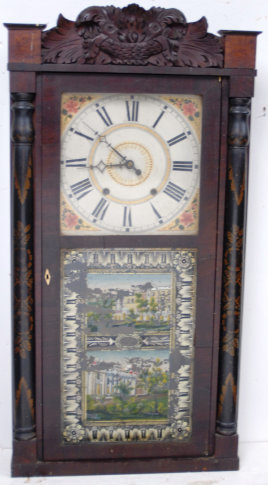
173. $100
“Eli Terry, Jr., Terryville, Connecticut”, short pendulum column and splat with turned feet, ca 1831. For what it’s worth department, the post office in Terryville was established in 1831.There is some notes about movement types in the clock, they may tell which movement is in this clock. I cannot remove the dial without breaking it. I don’t know if the back comes off with the movement attached, or what the deal is. The dial is certainly different, extremely dark as is the entire case. Glasses are probably replacements but everything else appears to be original including, dial, hands, pendulum, bell, stenciling, and turned feet. I could not inspect the 30-hour wood movement. There are no weights with this clock. $100-$200.
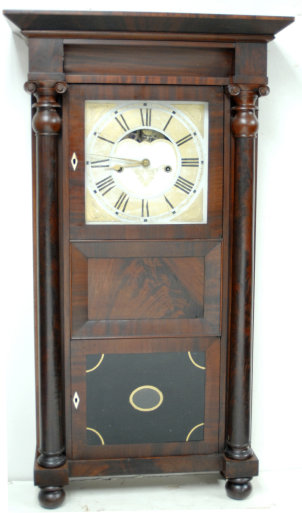
174. $300
“C & N Jerome, Bristol, Conn.”, extremely nice cornice top, full column, 8-day shelf clock in excellent condition with little change since made about 1828-1830. The reverse painted tablet is a replacement and the top glass may also be a replacement. The rosewood veneered case is 38” high, and is clean and polished. There are two ivory escutcheons on the two doors, working locks, and no key. There are full turned columns with unusual capitals. The center section that is normally glass in most clocks of this style is a rosewood panel. It has an 8-day brass movement that is clean and operational, excellent wood dial, pair of period hands, pair of old iron 8-day weights, coil gong, and an old pendulum bob. Paper label is about half there, enough to read the important parts. An almost identical clock is pictured and the making of these clocks is discussed, in the book, “From Rags to Riches to Rags: The Story of Chauncey Jerome”, by Chris H. Bailey; NAWCC Bulletin Supplement #15, Spring, 1986. $350-$500.
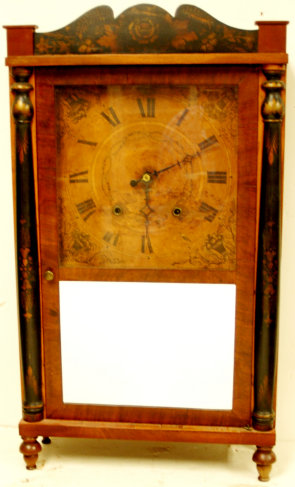
175. $100
“Ray & Ingraham, Bristol, Conn.”, 30-hour OG mantel clock, ca 1841-1843. I bet you have never heard of this clockmaker, I sure had not. It was a partnership between Benjamin Ray and Andrew Ingraham. They were case makers, not sure where they got their movements. This is a rosewood veneered case, 26 inches tall, and in very nice condition. Not sure if the tablet is original, looks like it is, but I have never seen a glass like this one. On the other hand I have never seen another clock by this maker. The dial has a couple of scratch marks, movement is unsigned, good paper label, old hands, coil gong, and old pendulum. $100-$200.
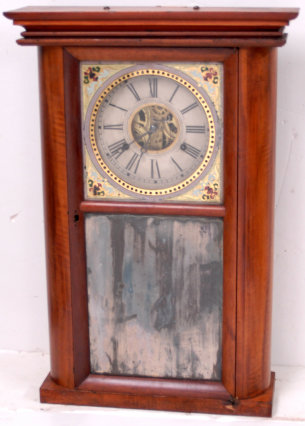
176. $100
“C. & N. Jerome / Bristol, Conn.”, on the complete card label inside this ca 1837-38 shelf clock. The unusual designed case is 22.25” high, has rounded sides, beveled door frame with key lock. There is no escutcheon or lock. Originally there was blue paper on the backboard and a card label. Most of the blue paper is gone but the card is intact. The base is flat, and the top trim is inverted. The zinc painted dial has the numerals painted directly on the raw dial plate. The movements for this model came two ways, both were the OG type, one with solid wheels and one with open wheels, and there is an enlarged center opening of the dial. It is thought that was done so people could see that it was not a wood movement. Brass movements were a new invention. The movement in this clock is made with the same early features except the wheel plates are not solid. The lower glass is a replacement. There are 30-hour iron weights, pendulum, and crank. Ly-American Clocks, Volume 3, page 134. $150-$250.
